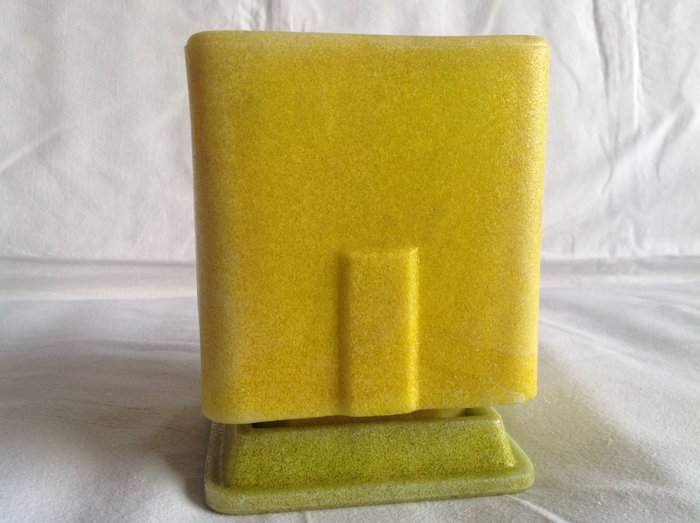Nro. 15330263

A.D. Copier - cactus pot with base - graniver
Nro. 15330263

A.D. Copier - cactus pot with base - graniver
Cactus pot with dish designed by A.D. Copier in 1928-1929 and produced by N.V. Glasfabriek Leerdam. Created with the graniver pressed glass technique (see the book Copier Compleet 1901-1991, pages 345, 346, 347). The cactus pot is marked with CL and the number N.O. 11987. The base is also marked with CL and N.O. 11987.
Copier himself describes the pot as a "flower pot", instead of a "cactus pot".
Colour:
Cactus pot lemon yellow
Dish yellow with a green tint
On the upper edge, the cactus pot shows slight discolourations and on the upper edge on the inside there is minimal damage. The pot has a few small cracks at the top (see photo 8). The bottom of the pot is perfect but is slightly discoloured.
The plate is in good condition. On the underside, on the inner ring, there is one minor chip.
Dimensions pot plus base together approx. 13.8 cm high
Dimensions pot:
High approx. 12.7 cm.
Diameter approx. 10.6 cm.
Dimensions base:
Height approx. 2.3 cm.
Diameter approx. 10.6 cm.
Weight:
1.2 kg.
About the history of origin:
"FLOWER POTS AS BUILDING BLOCKS
The square ‘building block flower pots’ designed by Andries Copier date from the same period as the ball vase. They are made of graniver, a kind of pressed glass developed by the Glasfabriek Leerdam, patented by the factory in 1921. It was also called sand glass due to the granular structure. Since the material is both cheap and strong, while it furthermore could also easily be coloured, it was deemed very suitable for the production of tiles and flower pots.
The first flower pots, primarily intended for cacti and succulents which at the time were very popular, were round and rest with cylindrical legs on a likewise round dish. The model currently in the window sill in the living room is the square version, which was formed two years later in 1929. The square variant has two rectangular thickenings and ditto deepenings so that the pots can be interlinked. That way one could decorate the window sill with a continuous series of flower pots, creating a 'strong decorative effect'. As explained in the brochure that recommended the square building block flower pots upon their introduction under the telling title ‘A find!’. "
Will be sent by registered mail
Tämä esine oli esillä kohteessa
Näin ostat Catawikistä
1. Löydä jotain erityistä
2. Tee korkein tarjous
3. Maksa turvallisesti
